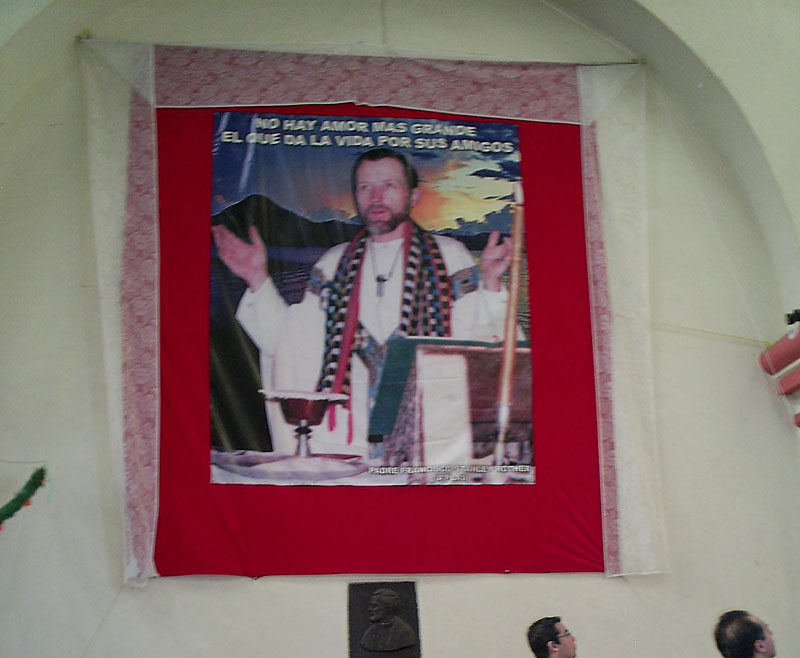LITTLE ROCK, Ark. – The path to sainthood in the Catholic Church is long, but supporters of a murdered Oklahoma priest hope he will one day be recognized as a saint.
The Rev. Stanley Rother was 46 when he was killed in July 1981 while serving in Santiago Atitlan, Guatemala. He had been ministering to the Catholic community there for 13 years, including during the tumultuous years of political strife in the 1970s and into 1981.
Rother knew the dangers. Other priests had been killed. But he refused to abandon his flock, writing in a 1980 letter, “The shepherd cannot run at the first sign of danger.”
Anthony Taylor, bishop of the Diocese of Little Rock, served as the episcopal delegate for the cause for canonization while working in the Archdiocese of Oklahoma City before he was named bishop in Arkansas. He continued working with the committee while in Arkansas.
As the episcopal delegate, Taylor was charged with investigating Rother’s death and interviewing witnesses and members of his community in Guatemala. He made several trips to the country, conducting about 50 interviews.
“I conducted all the Spanish-language interviews and investigations in Guatemala and some of the English ones in the United States,” Taylor said. “Once I became bishop, my successor finished the English ones.”
‘HE WASN’T LOOKING FOR A FIGHT’
Taylor said Rother had reason to believe that as a U.S. citizen he would be at less risk than the other priests.
“He knew that would not be absolute protection but it would provide a certain amount of freedom,” Taylor said. “He was very discreet and was not adversarial. He wasn’t looking for a fight.”
Taylor said Rother was sent to Guatemala to serve the Tzutujil people. He began working there in 1968 with a few others but by 1975 he was the only clergy remaining at the mission.
“It’s in the highlands of Guatemala,” Taylor said. “The population is almost entirely indigenous, so Spanish was not the native language. They were extremely poor.”
At the time the archdiocese took over the mission in the 1960s, the life expectancy in the area was 42, Taylor said.
“They had a very high infant mortality rate,” he said. “No school, no drinking water. Everything was out of the lake which was also the sewer, so public health was very poor.”
REPRESSION’S DEADLY TOLL
As Rother toiled far from home, civil war in the country drew closer to the remote town and, on the night of July 28, the priest was shot in the church rectory.
After Rother’s death, the archdiocese did not send other priests to the area until 1984. The community was served by priests from Guatemala until then. Taylor made several trips to the mission in the 1980s to check on the priest serving the community. He said military oppression was at its height during the 1980s.
“People were being killed routinely,” he said.
The committee for the cause of canonization began working on the 25th anniversary of Rother’s death, and this year, for the 30th anniversary, a group from Arkansas and Oklahoma made a pilgrimage to Santiago Atitlan.
The work of the committee, the so-called discovery phase, was passed on to the Congregation for the Causes of Saints in Rome. The future of the cause of canonization will be decided by this group.
If Rother is canonized, he will be the first American-born male saint.
THE PATH TO SAINTHOOD
“He’s a very strong model of priestly holiness and American holiness and courage,” Taylor said. “He comes from a very humble background. He would have been one of those people that would not have stood out but who was really faithful.”
Two paths for canonization exist: One is the path of heroic virtue, the other is for martyrdom. The committee from the archdiocese conducted interviews to cover both possibilities, Taylor said.
To achieve sainthood for heroic virtue, two miracles attributed to the would-be saint must be authenticated, the first for beatification or to be called “blessed,” the second for canonization as a saint. For martyrdom, the evidence must prove Rother was killed because of his faith.
Send questions/comments to the editors.



Success. Please wait for the page to reload. If the page does not reload within 5 seconds, please refresh the page.
Enter your email and password to access comments.
Hi, to comment on stories you must . This profile is in addition to your subscription and website login.
Already have a commenting profile? .
Invalid username/password.
Please check your email to confirm and complete your registration.
Only subscribers are eligible to post comments. Please subscribe or login first for digital access. Here’s why.
Use the form below to reset your password. When you've submitted your account email, we will send an email with a reset code.